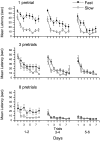Conceptual, spatial, and cue learning in the Morris water maze in fast or slow kindling rats: attention deficit comorbidity
- PMID: 12196604
- PMCID: PMC6757963
- DOI: 10.1523/JNEUROSCI.22-17-07809.2002
Conceptual, spatial, and cue learning in the Morris water maze in fast or slow kindling rats: attention deficit comorbidity
Abstract
Rat lines selectively bred for differences in amygdala excitability, manifested by "fast" or "slow" kindling epileptogenesis, display several comorbid features related to anxiety and learning. To assess the nature of the learning deficits in fast kindling rats, performance was evaluated in several variants of a Morris water-maze test. Regardless of whether the location of the platform was fixed or varied over days (matching-to-place task), the fast rats displayed inferior performance, suggesting both working and reference memory impairments. Furthermore, when the position of the platform was altered after the response was acquired, fast rats were more persistent in emitting the previously acquired response. The poor performance of fast rats was also evident in both cued and uncued tasks, indicating that their disturbed learning was not simply a reflection of a spatial deficit. Moreover, fast rats could be easily distracted by irrelevant cues, suggesting that these animals suffered from an attentional disturbance. Interestingly, when rats received several training trials with the platform elevated, permitting them to develop the concept of facile escape, the performance of fast rats improved greatly. The performance disturbance in fast rats may reflect difficulties in forming a conceptual framework under conditions involving some degree of ambiguity, as well as greater distractibility by irrelevant cues. These various attributes of the fast rats may serve as a potentially useful animal model of disorders characterized by an attention deficit.
Figures








References
-
- Aggleton JP, Hunt PR, Rawlins JNP. The effects of hippocampal lesions upon spatial and non-spatial tests of working memory. Behav Brain Res. 1986;19:133–146. - PubMed
-
- American Psychiatric Association . Diagnostic and statistical manual of mental disorders, Ed 4. American Psychiatric Association; Washington, DC: 1994.
-
- Anisman H, Lu ZW, Song C, Kent P, McIntyre D, Merali Z. Influence of psychogenic and neurogenic stressors on endocrine and immune activity: differential effects in fast and slow seizing rat strains. Brain Behav Immun. 1997;11:63–74. - PubMed
-
- Anisman H, Kelly O, Hayley S, Borowski T, Merali Z, McIntyre DC. Acoustic startle and fear potentiated startle in rats selectively bred for fast and slow kindling rates: relation to monoamine activity. Eur J Neurosci. 2000;12:4405–4416. - PubMed
-
- Bannerman DM, Good MA, Butcher SP, Ramsay M, Morris RG. Distinct components of spatial learning revealed by prior training and NMDA receptor blockade. Nature. 1995;378:182–186. - PubMed
Publication types
MeSH terms
LinkOut - more resources
Full Text Sources
Medical
